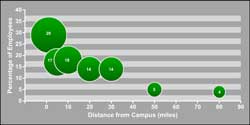GIS-Based Project Supports College's Commitment to Climate Neutrality
This article as a PDF .
In 2007, Green Mountain College (GMC) became the first institution of higher education in Vermont to sign the American College & University Presidents Climate Commitment (ACUPCC). This is an agreement by colleges and universities to take practical measures to limit greenhouse gas emissions associated with campus operations and promote research and educational efforts toward climate neutrality. In response, students at GMC used GIS to create a baseline inventory of faculty and staff commuting trends to limit the college's carbon footprint.
 |
| A summary of the percentage of faculty and staff at Green Mountain College living within specified communting distances. |
GMC is a small liberal arts college in rural Vermont. Its environmental mission provides the underpinnings for its general education program and led to two ambitious goals: to substantially lower greenhouse gas emissions and purchase offsets for emissions that cannot be reduced. To reach these goals, GMC integrated this initiative into the curriculum through interdisciplinary departmental collaboration and service-learning projects.
After assessing the results of a greenhouse gas inventory in 2007, the college outlined short-, mid-, and long-term goals for emissions reduction with the goal of achieving climate neutrality by 2011. While installing a combined heat and power (CHP) biomass facility in 2009 would reduce most of the college's emissions, improving the GMC fleet's fuel efficiency and creating a transportation demand management system will reduce emissions related to transportation, the second largest contributor to GMC's carbon footprint.
GMC faculty and staff who live in western Vermont and eastern New York commute to work. To achieve climate neutrality, GMC must consider how far each faculty and staff member travels, vehicle efficiency, and frequency of commute. In spring 2009, two students created a preliminary baseline inventory of faculty and staff commuting trends using GIS.
Each spring, students in the Introduction to GIS course must participate in a service-learning project working with a community partner to help address an issue of concern. Jane Day and Kyla Jaquish, students in the spring course, selected the commuter inventory for their semester project.
Day and Jaquish used a database that included 141 of the 224 faculty and staff who work at the institution. Primary data provided home addresses but did not include the type of vehicle for each commuter. After identifying the geographic coordinates for each commuter address, the students created a commuter address shapefile.
They performed a cost-distance analysis along the roads in Vermont and New York, assuming the cost of traveling through each grid cell of 30-meter digital elevation model (DEM) data actually was 30 meters. This provided a more accurate representation of distance traveled than a straight-line-distance analysis. Using a spatial join, the address shapefile was used to extract from the cost-distance grid the distance traveled for each commuter. These distance values were exported to Microsoft Excel and used to characterize commuter trends and provide a baseline estimate for total gasoline consumption, total miles driven, total carbon emitted by employee vehicles, and employee distance from the college.
These values indicate faculty and staff drive a combined total of 3,136 miles each day, and assuming an average fuel efficiency of 23 mpg/highway, this daily commute consumes approximately 174 gallons of gas, creating approximately 1.5 metric tons of CO2 per day. Assuming each employee commutes three days per week, the total annual carbon emissions from commuting are approximately 234 metric tons. However, because 50 percent of these commuters live within five miles of campus, there is strong potential for developing an efficient carpooling infrastructure.
These assumptions and estimates will be further refined as addresses become available for remaining employees and when data summarizing actual car models and frequency of daily commutes is collected. The baseline inventory can be expanded as more data becomes available. Through this project, students used GIS to address a community issue and helped the campus move toward its goal of climate neutrality.
|